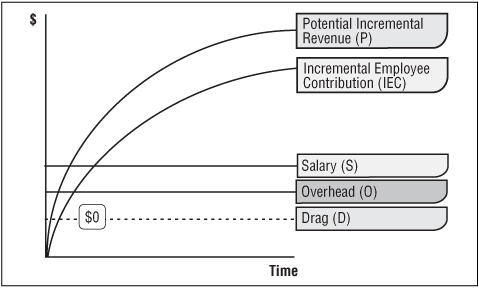The Incremental Employee Contribution Model
The Incremental Employee Contribution or IEC model combines the concepts described above; a simplified version is described here. Mathematically, the incremental value that an employee provides within the system can be described as:
| Pt | Potential incremental revenue on day t attributable to this employee. |
| St | Salary cost on day t for this employee. |
| Dt | Drag cost on day t. |
| Ot | Allocated overhead cost on day t. |
| U | Total up-front acquisition cost for this employee. |
Graphically these relationships are shown in Figure 4.1.
Figure 4.1.

Descriptively, this model is a statement of the following inputs, effects, links, and causality.
The longer employees are on the job, the more productive they become. Learning theory supports this proposition and allows for the quantification of a learning curve, which relates the level of productivity, skill, capacity, or capability to length of time on the job (Teplitz 1991).
System resources in the form of such things as training materials, additional management oversight, and so on.
Overhead costs are constant over time.
Salary stays steady over time.
The incremental value of an employee is negative on the first day, becomes positive over time, and then eventually levels out at a steady rate of productivity (asymptotic).
Each of these statements involves some implicit or explicit set of assumptions and beliefs. These points ...
Get Ultimate Performance: Measuring Human Resources at Work now with the O’Reilly learning platform.
O’Reilly members experience books, live events, courses curated by job role, and more from O’Reilly and nearly 200 top publishers.

